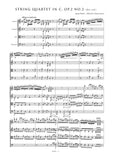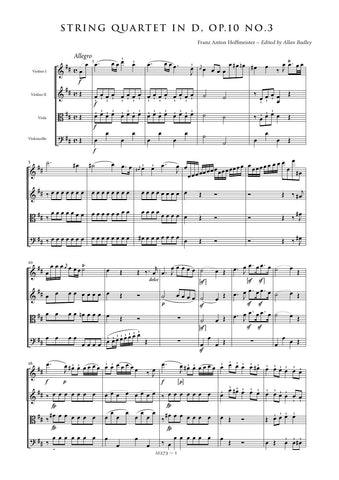Details
|
Pleyel's Op.2 String Quartets were first published in 1784 by the Viennese publisher Graeffer. They were advertised in the Wiener Zeitung on 15 December of that year and appeared with a dedication to Joseph Haydn. All six works reveal Pleyel as a composer of considerable skill and accomplishment. Thematic invention is consistently high across all six works and some movements, many of the sonata forms in particular, are remarkable for the rich variety of musical material presented. Likewise Pleyel handles sonata form with flair and imagination. The first movement of the fifth quartet, for example, contains a false reprise that forces substantial recomposition in the recapitulation, and there are at least two examples of mirror recapitulations where the main theme resurfaces only during the closing stages of the movement (first and second movements of the first quartet).
All but one of the Op.2 Quartets are in three movements (the exception is the fourth quartet in E flat which adds a brief 29-bar Minuet between its slow movement and finale). The slow movements are directed to be played con sordini (as Haydn often did in many symphony slow movements); these are generally finely wrought cantilenas with the focus firmly on the first violin. Formally the most interesting is that of the sixth quartet. The first 50 odd bars of the movement suggest variation style and structure as (as do the sectional headings in the source), but the main theme is not really varied at all, despite its promise. Instead the movement unfolds as a series of couplets, only the first of which stays in the tonic. Each of these focuses on a different instrument. With the reprise of the theme in between (ma senza replica), and the gradually diminishing surface rhythms typical of the variation style, the movement becomes an extended variation-cum-rondo structure - a relative perhaps of Haydn's favourite alternating or double variation form. Additional structural interest results from the way Pleyel resolves the dominant chord right at the end of the movement directly into the first chord of the hunt-styled Presto finale.
Throughout the six works Pleyel's use of the harmonic lingua franca of the period is personalised through occasional chromatic shadings - for example the extensive use of the neapolitan in the slow movement of the first quartet. There are also numerous instances of sudden modulations - for example, towards the start of the first movement development sections of the first and fifth quartets, or the juxtaposition of third-related keys as in the C major - A flat major combination in bars 29-30 of the slow movement of the second quartet. The best of the finales adopt the breezy, popular style typical of the classical Viennese quartet. The rondo movement concluding the fifth quartet shows clearly the influence of Haydn in both thematic structure and overall mood.
The present edition reproduces as faithfully as possible the text of the Op.2 Quartets as transmitted in Graeffer's first edition of the works, a copy of which is preserved in the Gesellschaft der Musikfreunde archives in Vienna. The style and notation of articulation and dynamic markings have been standardised throughout, and, where missing from the print, markings have been reconstructed from parallel passages. Like most eighteenth-century sources, the Graeffer edition is very inconsistent in its notation of appoggiature ; these have been standardised to minimise confusion. Obvious wrong notes have been corrected without comment, and editorial emendations with no authority from the print are placed within brackets.
Allan Badley
Dianne James
|















